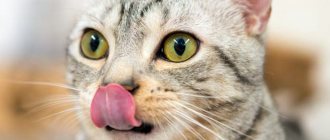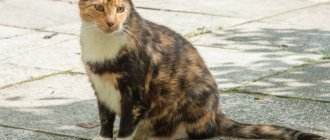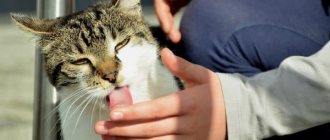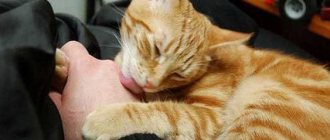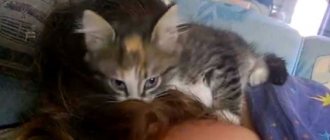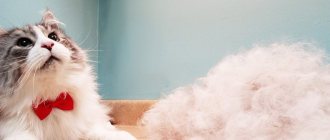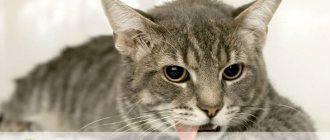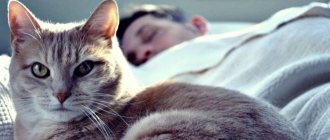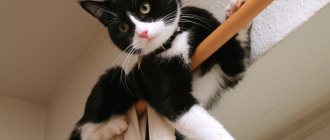It is well known that cats are great lovers of cleanliness. Furry pets spend a significant part of their time getting their fur in perfect order. A healthy cat has shiny and fluffy hair. If there are several cats in the house, then the animals can lick each other, helping to ensure the perfect condition of the fur coat and thus expressing affection. Some cats do not limit their care to their relatives and begin to lick the owner's head. Owners experiencing discomfort do not understand the reasons why the cat licks its hair.
Causes
The most obvious reason for a cat to lick its owner's head is the usual love of cleanliness. The cat shows such a sign of attention to express a kind attitude. Other possible explanations for cat behavior include:
- Expression of feelings. The mother cat shows care for the babies by licking their fur coats. Such a ritual signifies recognition of family ties and affection.
- It has been noticed that the cat does not mind receiving any treat in return for his care. A pet that notices a treat expresses feelings in hopes of being rewarded with food.
- The need to dominate. By licking kittens, a cat denotes its seniority and the authority of the parent. By doing the same with the owner, the pet demonstrates its own importance.
- The pet's stiffness and tension when performing the ritual of cleaning the owner's head means a subordinate position. Signs of self-doubt indicate the presence of a behavioral problem: the pet is scared and feels defenseless.
- Licking the owner's hair (sucking hair) may indicate that the cat is bored and cannot find something to do. It is recommended to expand the cat's living and playing space: equip a cat tree, a scratching post, and a shelf for lying on.
- It is likely that the cat is irritated by the strong odors coming from human hair. Animals perceive the use of styling gel or hairspray by humans as an attempt to invade a protected area. By removing traces of cosmetics, the cat seeks to protect the owner from possible danger.
- If a cat licks itself all day long, swallows fur, tufts of fur on the owner’s clothes, this may be a sign of illness. Your pet should be examined for signs of allergies, dermatitis, or infestation by parasites such as ear mites.
How to remove fur from a cat's stomach?
If you cannot prevent this problem from occurring, you should think about how to solve it. There are several ways:
- Hair removal paste. Thanks to its composition, the paste promotes the natural removal of hair from the cat’s gastrointestinal tract. In addition, it improves appetite and digestion.
However, this paste may be useless if there is too much hair. Before use, consultation with a veterinarian is necessary.
- Hair removal tablets. According to the principle of action, they are similar to paste.
- Food for hair removal. For example, the Royal Canin line includes Hairball Care food to prevent the formation of hairballs in a cat’s stomach.
Kitten climbs into man's hair
When the kitten has eaten, played and is about to take a nap, the baby gets a special pleasure from playing with the owner’s hair. Fluffy hair reminds the pet of early infancy, when the cub associated warmth, food and protection with thick maternal fur.
Often the kitten instinctively buries itself and looks for a source of milk in its hair, since it is accustomed to doing this in the first weeks after birth. This behavior is especially characteristic of the smallest pets that have been separated from their mother. Until the kittens grow up enough and forget about breastfeeding, from time to time the babies will look for their mother's nipple.
Cat licks hair
In some cases, licking the hair on your head may be caused by the scent of the shampoo that is interesting to your cat. But more often than not, if your cat isn't doing anything other than licking her hair, there's no need to sound the alarm - she's not going to eat you for breakfast! This is a gesture of care and a sign that your pet loves you, because in the world of cats, individuals who trust each other are sure to wash each other. It's like a caress. This is what cat friends and mother cats do to kittens. There is no need to scold the tailed one for this, because he comes to you with all his heart.
But if this has turned into a real problem, the cat is disturbing your sleep and you are very irritated, you can hiss at him every time he tries to lick your head. In cats, this is a warning sign, meaning that you are very unhappy and are ready to take extreme measures if this behavior continues to be applied to you. After a few times, the cat should remember that you don’t like it, although he will be surprised.
Rate and share!
The cat pulls out hair
When playing with hair, some cats can cause significant pain to a person (chewing, biting). How to break the habit? There is no need to encourage this behavior, otherwise the pet will get used to tormenting the owner in search of entertainment and games. Cats understand intonation well, so a sharp shout is usually enough to make the animal stop. If a verbal ban does not help, you need to quickly remove the naughty pet from the room. As soon as the cat understands that an attempt to pull hair is followed by confinement in solitude, the animal develops a conditioned reflex and further attempts at such play will stop.
How purring occurs
The sound originates between the base of the skull and the base of the tongue. In the cat's brain, impulses arise that provoke contraction of the muscles near the vocal cords. The bones under the tongue create a vibration that spreads throughout the animal's body.
Their ability to purr depends on the structure of the hyoid bone of baleen animals. Domestic cats have a triangular-shaped bone, thanks to which they are able to purr continuously both when exhaling and inhaling. Large felines have a rectangular bone under the tongue. This allows them to make roaring sounds to intimidate and scare away enemies, but they can only rumble when exhaling.
Video with a visual demonstration of the anatomical causes of purring:
Many other animals make sounds similar to purring, such as guinea pigs, rabbits, raccoons and hyenas. But this cannot be called purring to the fullest extent. Only cats can truly do this.
Reference! While purring, it is impossible to listen to the animal's heart and lungs.
Weaning a cat from the habit of licking its head
The habit of a cat licking a person's head is not pathological, but it can irritate the owner of the animal or family members. To change this behavior pattern, the following methods are recommended:
- interest your pet in outdoor games;
- take the cat in your arms and caress it, scratch its ears or belly;
- change the position of the body so that the cat cannot reach the head;
- take a pet brush and take care of your furry pet’s fur.
Preventing hairball formation
During the period of heavy shedding of the pet, it is especially important that the owner pays due attention to preventive measures. Owners of long-haired cats should constantly monitor these processes. There are several most effective methods:
- Timely combing
It is recommended to brush cats with long hair daily in spring and autumn - during the period of active hair growth. Short-haired pets can be brushed less frequently: three to four times a week should be enough.
- Grass for cats
Wheat germ or oats are also stomach cleansers. But be careful: in some cases, veterinarians recommend using a special paste to help get rid of hair in the stomach.
Gray hair in cats
Representatives of the cat family can change color throughout their lives. Such changes can occur repeatedly (up to three times). This process is associated with hereditary factors and may resemble the appearance of gray hair in humans, especially if among the animal’s ancestors there were individuals with gray or smoky skin. Felinologists have coined the term “reblooming” to describe this phenomenon. The change in color is quite typical for black cats. In the early period of development, the color of the skin changes between ashy and brown, finally being determined when the pet reaches one and a half years.
Age-related changes in pigmentation are characteristic of all mammals. If the color of the coat changes sharply, over a short period of time, there is reason to worry and take your pet to the veterinarian.
In addition to color change, there are other reasons why a cat changes the shade of its coat. The color and density of wool is affected by seasonal temperature fluctuations. This effect is especially characteristic of Siamese, Burmese, and representatives of the Himalayan breed. In winter, these cats' fur becomes darker, and in the summer months it fades in the sun and becomes chocolate-colored. In some individuals, with age, a pattern appears on the skin in the form of strokes and lines, which was absent in youth. Such contours are drawn with whitened hairs.
Causes of graying
If the owner notices a change in the color of the pet’s fur, the following reasons for the origin of this phenomenon should be checked:
- Stressful condition. Some cats react painfully to the need to move from place to place or separation from family members. The appearance of a new pet can also serve as a source of anxiety, as can any change in the situation, perceived as a threat to the usual way of things.
- Complications after illness or surgery. Anesthesia, long-term use of medications, and allergic reactions lead to changes in the structure of the fur in certain areas of the body surface. After the body recovers, new hair will grow.
- Age-related changes. The average age of cats at which age-related graying becomes noticeable is 8 – 12 years. In general, the process of changing hair pigmentation is individual in nature. Some cats begin to change the color of their fur from the age of three, while other cats retain their charcoal color from birth until old age.
- Diet. The rich color of a cat's fur is ensured by the presence of melanin pigment in the fibers of the fur coat. A lack of trace elements, copper and amino acids that contribute to the production of this substance, can lead to the animal’s fur becoming dull and pale. In this case, the veterinarian prescribes a vitamin-mineral complex for the pet.
The appearance of gray hair in a cat is not associated with senility and does not portend imminent death. Hereditary factors can influence the discoloration of the fur coat. If the kitty retains all the signs of a healthy animal, does not lose hair, has a good appetite, a cheerful mood, and regular bowel movements, there is no reason to worry. If other alarming symptoms occur, you should take your furry pet for examination and consultation to a veterinary clinic.
Cat eats hair from the floor
Sometimes hair falls from our head straight to the floor. We cannot notice this, nor the fact that the pet found and ate them. This unwanted behavior is difficult to control. Of course, if you see it, you need to stop the cat from doing this and remove the hair from its mouth. But, unfortunately, more often this happens in our absence.
What are the dangers of eating hair? Firstly, a clump of your hair, like your own fur, can get stuck somewhere in the cat's intestines, causing an obstruction. Then he will need to eat grass to pull out or push the mat further. In rare cases, surgery is required.
Article continues after advertisement
In addition, eating hair can lead to an interesting situation. Case from practice. The cat ate long hair that successfully reached the rectum. Then she went to the toilet: the feces, which should have come out, came out along with part of the hair, and the second part of the hair remained in the butt. As a result, the cat crawled out of the tray with a piece of hair hanging from its anus, and tried to wipe it on the floor. Fortunately, the owners noticed immediately and pulled everything out of the cat themselves.
To prevent negative consequences after eating hair, you need to regularly give your cat pastes and pads to remove hair.
